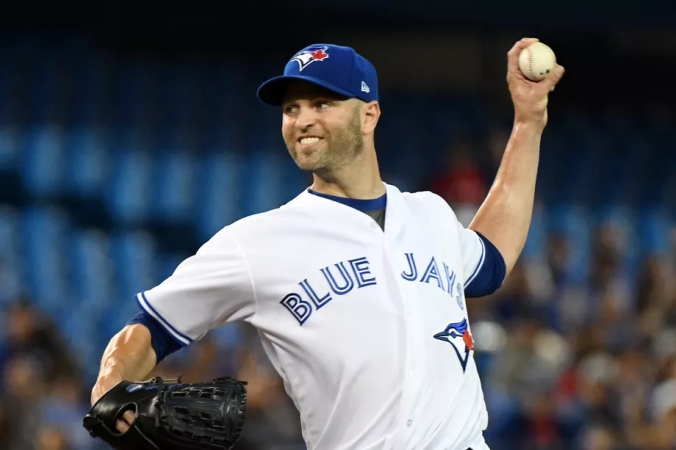
Dan Hamilton (USA Today)
Which pitcher has the 18th lowest ERA since 2015, with a minimum of 400 innings pitched? Any guesses? JA Happ you say? Wrong, it’s Indians hurler Carlos Carrasco. But Happ and his 3.43 ERA come in 19th, bookended by the aforementioned Carrasco and Johnny Cueto at 20th, impressive company to say the least.
Hold on a second. You’re saying that JA Happ, the 35-year old guy that pronounces his acronym’d name “Jay” instead of “J.A.”, has been the 19th best run preventer in baseball for the last three years? Ahead of names like Stroman, Gray, Tanaka and Archer? Yes, that is what I’m saying. Check Fangraphs if you don’t believe me.
JA Happ, despite his #1-2 level starter performance over the last three years, doesn’t get the recognition he deserves. Take this example. When I justified my drafting of Happ in the 21st round in my fantasy league by saying he would help anchor my pitching staff, my league mate said, “I didn’t think Ian Happ could pitch”?

To get a flavor for what I’m talking about, let’s compare Happ’s stats over the last three MLB seasons to two mystery pitchers. This type of blind trial can help us shed our preconceptions about players and get to the brass tacks – their production. In 511 innings in that span Happ has produced a 3.43 ERA and 1.25 WHIP. Mystery Pitcher 1 has pitched a similar amount of innings to Happ and totaled a 3.52 ERA and 1.23 WHIP. Pitcher 2 has shown to be more durable, averaging over 200 innings per season, and comes in at a 3.55 ERA and 1.22 WHIP. From a run and base runner prevention standard, the pitchers are virtually identical.
Yet their draft positions, as reported by FantasyPros, are not. Pitchers 1 and 2 are being taken in the sixth to seventh rounds in drafts, right alongside bats like Daniel Murphy, Robinson Cano, Wil Myers and AJ Pollock. Happ is being drafted in the 240s on average, surrounded by such esteemed hitting talent as Todd Frazier, Ryon Healy and Marcus Semien. Doesn’t that differential seem a bit curious when considering the seemingly identical production of Happ compared to the mystery pitchers?
Now there’s certainly more to being a pitcher than just ERA and WHIP, and we can only rely so much on a data set that includes 2015 figures. After all, John Lackey and his 3.49 ERA / 1.25 WHIP since 2015 would compare favorably to Happ and the mystery pitchers, and I certainly wouldn’t advocate targeting him in fantasy. So with that let’s check out an expanded set of statistics that focuses on 2017 performance.
Happ looks great from an ERA perspective here, as the mystery pitchers above came in  well above 4.00 on the run prevention front compared to Happ’s 3.53 ERA in 2017. All three compare about evenly on FIP and xFIP metrics, while Happ’s WHIP is a bit worse. Happ struck out more batters per nine than Pitcher 1 but less than Pitcher 2, however Pitcher 2’s strikeout rate last year was a bit of an aberration. All three pitchers have above average to good control and come in with K/BB ratios north of 3.00.
well above 4.00 on the run prevention front compared to Happ’s 3.53 ERA in 2017. All three compare about evenly on FIP and xFIP metrics, while Happ’s WHIP is a bit worse. Happ struck out more batters per nine than Pitcher 1 but less than Pitcher 2, however Pitcher 2’s strikeout rate last year was a bit of an aberration. All three pitchers have above average to good control and come in with K/BB ratios north of 3.00.
Each pitcher is roughly average at inducing ground balls, with Happ having the slight edge of the three at 46.9%. All three are also good at inducing soft contact, with Happ falling in between Pitcher 1’s 23.9% and 2’s 18.2%. Happ’s swinging strike rate of 9.4% and Pitcher 1’s of 9.5% are right around league average for a starter, while Pitcher 2 lags behind at 8.4% (thus the fluky nature of his 9.87 K/9).
If you couldn’t tell, these pitchers had very similar 2017’s by a host of surface level and underlying pitcher metrics. Yet their draft positions diverge markedly. Happ is being selected as an also-ran and is owned in only 51% of ESPN leagues, while fantasy managers are forgoing serious offensive talent to select the mystery pitchers. What gives?
I suspect some of it has to do with Happ’s age. At 35.45 years old, Happ is an old geezer by the standards of the mystery pitchers. Having made his MLB debut all the way back in 2007, and first gaining fantasy relevance in 2009, Happ’s name suffers from a certain degree of a fantasy fatigue. Another thing that hurts Happ’s popularity is his odd career trajectory. He came out guns blazing in 2009 and 2010 with the Phillies, but spent the next five years struggling with injuries and hopping from franchise to franchise. It wasn’t until Happ’s Cy Young-caliber, 20-win 2016 season that he began to show up on the radar again. But fantasy owners have short memories, and after some injuries sidelined Happ in the middle of 2017, people quickly forgot about him again.
Another issue likely revolves around Happ’s seemingly pedestrian pitch arsenal. Happ throws the kitchen sink at hitters, using a full five pitch mix and failing to dazzle, at least on the surface, with any of them. His four-seam fastball, which was used 42% of the time in 2017, averages a decent but hardly noteworthy 92.9 MPH. His sinker, at 29.1% usage, is a passable 91.0 MPH and is mainly used to induce groundballs. His off-speed stuff, which he throws 28% of the time, is pedestrian. His slider only induces a whiff 8.8% of the time, and his curve, while effective, is thrown in only one out of 20 tries.
throws the kitchen sink at hitters, using a full five pitch mix and failing to dazzle, at least on the surface, with any of them. His four-seam fastball, which was used 42% of the time in 2017, averages a decent but hardly noteworthy 92.9 MPH. His sinker, at 29.1% usage, is a passable 91.0 MPH and is mainly used to induce groundballs. His off-speed stuff, which he throws 28% of the time, is pedestrian. His slider only induces a whiff 8.8% of the time, and his curve, while effective, is thrown in only one out of 20 tries.
So Happ’s old, has been around the block, doesn’t throw hard and has mediocre off-speed stuff? No wonder no one cares.
But take another look at the pitch mix table, particularly his four-seam fastball. While it doesn’t dazzle with speed, Happ manages to induce a whiff on 12.8% of those pitches. That’s actually an elite rate. Happ’s whiffs per swing on his four-seam fastball of 27.7% in 2017 was the fourth best among MLB starters, trailing only Jacob deGrom, Rich Hill and Danny Salazar. Other names in the top 10 included Chris Sale, Jimmy Nelson, Yu Darvish and Robbie Ray. That’s good company.
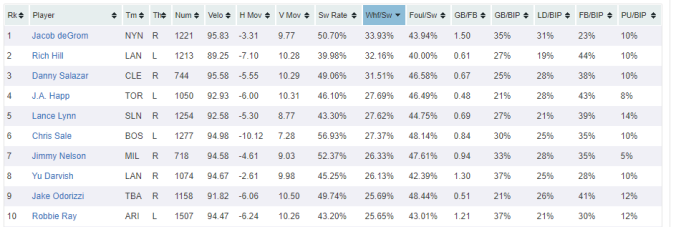
Source: Baseball Prospectus
Happ is known for having a deceptive delivery, which likely contributes to why hitters have difficulty picking up a fastball that struggles to top 95 MPH. He does most of his damage up in the zone with the pitch, earning whiff rates comfortably above 20% in the upper-third of the strike zone. Hitters also can’t seem to help themselves when Happ elevates the pitch further, with whiff rates ranging from 16% to 37% directly above the zone.
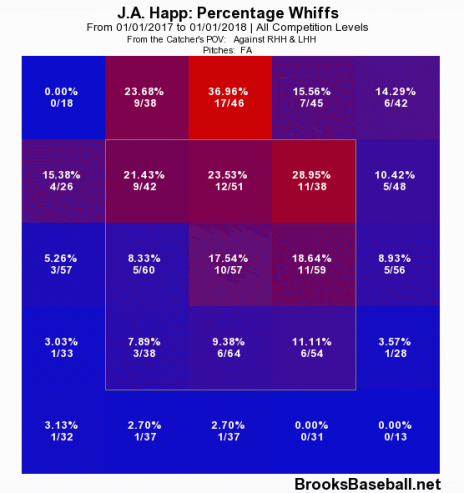
Whiff Rate on four-seam fastballs
Although it’s strange to say given his mediocre velocity, Happ’s “out-pitch” is his four-seam fastball. Through some combination of deception, location and sequencing, he’s able to get MLB hitters to swing and miss at it consistently. While Happ’s reliance on high fastballs might seem like a dangerous approach to baseball traditionalists, it’s actually a smart strategy given how hitters are revamping their swing planes to more of an uppercut trajectory. These new swings are great at hitting pitches in the lower to middle part of the zone out of the ballpark, but they’re awkward in dealing with letter high offerings.
But Happ also has yet another plus pitch. The sinker, while generating a roughly average 6.9% whiff rate, is a real worm-burner, getting groundballs on 62.4% of balls in play. It also induces weak contact, as Happ held hitters to a paltry 347 slugging against on the sinker in 2017.
While his four-seamer resides in the upper realms of the strike zone, Happ buries his sinker in the bottom third of the zone or below it completely. Impressively, Happ is able to induce a swing on over one-third of his sinkers below the strike zone. This leads to a lot of weak contact and helps explain the favorable groundball rate and slugging against he’s able to garner.
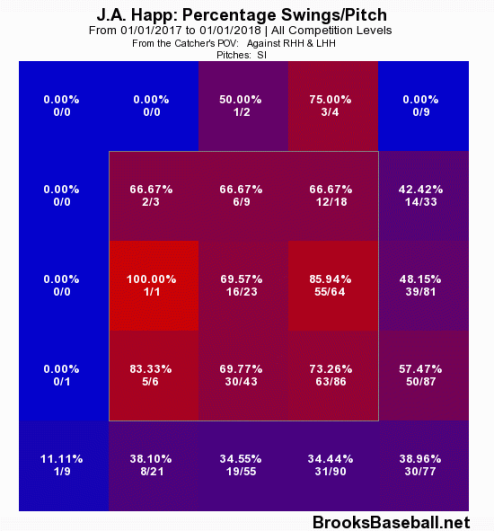
Swing rate on sinkers
But just how good is getting opposing batters to swing at one-third of your low-balled sinkers? If you’re like me, and relatively unfamiliar with swing rates on sinkers below the strike zone, you don’t have much of a clue. That’s where context helps. Let’s look at the master of sinker-induced, low-zone weak contact – Dallas Keuchel.
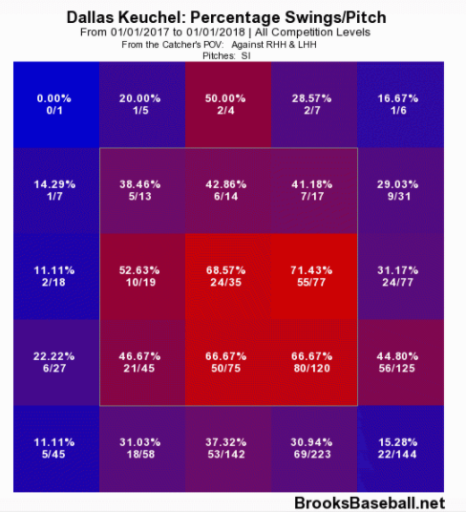
Swing rate on sinkers
Hot damn! Happ is better than Keuchel at getting hitters to swing at his low sinkers! Bet you weren’t expecting that.
Bringing this all together, Happ has two plus pitches, a four-seam fastball and a sinker, that he throws over 70% of the time. These pitches are effective in different ways. The fastball generates a disproportionate amount of swings and misses and serves as a real out pitch for Happ, however it’s prone to getting hit hard and in the air. Happ complements the fastball with a sinker that sits low in the zone, or out of the zone completely, and generates a lot of weak groundballs. While his secondary offerings are average at best, Happ’s dominance on hard stuff more than overcompensates. Also, look out if he starts throwing his curveball more, as that pitch has shown positive results over the years despite being seldom used.
When you combine Happ’s impressive boxcar stat performance, with his plus ERA, impressive amount of wins and adequate strikeout rate, with an understanding of what makes him stick on the mound, the only real conclusion one can draw is that he’s tremendously undervalued. This isn’t simply an old vet getting a bit lucky. He has some real, discernible skills behind his 3.43 three-year ERA. Grab him late, or pick him up off waivers, and profit.
Goddammit, who are the Mystery Pitchers?!
LikeLiked by 1 person
Mystery Pitcher #1 is Gerrit Cole and #2 is José Quintana.
LikeLiked by 1 person
Good writing s usual
LikeLike